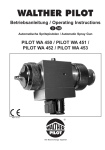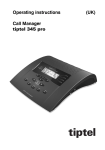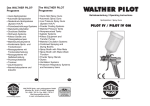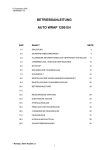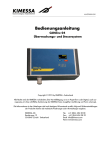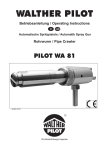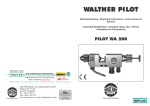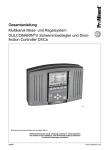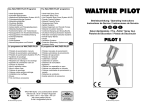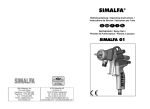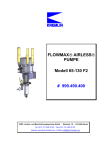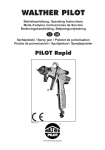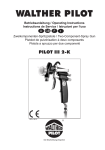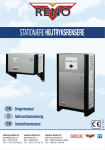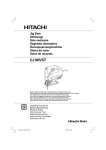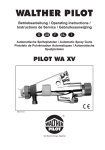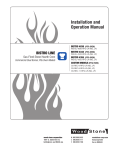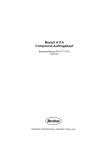Download WA 20 d + gb.qxd
Transcript
Das WALTHER PILOTProgramm The WALTHER PILOT Programme • Hand-Spritzpistolen • Automatik-Spritzpistolen • Niederdruck-Spritzpistolen (System HVLP) • ZweikomponentenSpritzpistolen • Pulverbeschichtungs-Systeme • Materialdruckbehälter • Drucklose Behälter • Rührwerk-Systeme • Airless-Geräte und Flüssigkeitspumpen • Materialumlaufsysteme • Kombinierte Spritz- und Trockenboxen • Absaugsysteme mit Trockenabscheidung • Absaugsysteme mit Naßabscheidung • Pulversprühstände • Trockner • Zuluft-Systeme • Atemschutzsysteme und Zubehör • Hand-Held Spray Guns • Automatic Spray Guns • Low Pressure Spray Guns (System HVLP) • Two-Component Spray Guns • Material Pressure Tanks • Nonpressurized Tanks • Agitator Systems • Airless Equipment and Transfer Pumps • Material Circulation Systems • Combined Spraying and Drying Booths • Dry Back Overspray Extraction Systems • Wet Back Overspray Extraction Systems • Powder Spray Stands • Dryers • Ventilation Systems • Protective Respiratory Systems and Accessory Items WALTHER Spritz- und Lackiersysteme GmbH Kärntner Str. 18-30 • D-42327 Wuppertal Tel.: 0202 / 787-0 • Fax: 0202 / 787-217 http://www.walther-pilot.de E-mail: [email protected] WA LTH ER PI LOT Betriebsanleitung / Operating Instructions Airless-Automatik-Spritzpistole / Airless-Automatic-Spray Gun PILOT WA 20 EG-Konformitätserklärung Declaration of CE-Conformity Wir, der Gerätehersteller, erklären in alleiniger Verantwortung, daß das Produkt in der untenstehenden Beschreibung den einschlägigen grundlegenden Sicherheits- und Gesundheitsanforderungen entspricht. Bei einer nicht mit uns abgestimmten Änderung an dem Gerät oder bei einer unsachgemäßen Verwendung verliert diese Erklärung ihre Gültigkeit. Hersteller WALTHER Spritz-und Lackiersysteme GmbH Kärntner Str. 18-30 D-42327 Wuppertal Tel.: 0202 / 787-0 Fax: 0202 / 787-217 www.walther-pilot.de • Email: [email protected] Typenbezeichnung Airless - Automatik Spritzpistole PILOT WA 20 V 20 950 We,the manufacturers of the equipment, hereby declare under our sole responsibility that the product(s) described below conform to the essential safety requirements. This declaration will be rendered invalid if any changes are made to the equipment without prior consultation with us. Verwendungszweck Verarbeitung spritzbarer Materialien Angewandte Normen und Richtlinien EG-Maschinenrichtlinien 98 / 37 EG 94 / 9 EG (ATEX Richtlinien) DIN EN 292 Teil 1 DIN EN 292 Teil 2 DIN EN 1953 Gerätebezeichnung II 2 G c T 5 Type Designation WALTHER Spritz-und Lackiersysteme GmbH Kärntner Str. 18-30 D-42327 Wuppertal Tel.: 0202 / 787-0 Fax: 0202 / 787-217 www.walther-pilot.de • Email: [email protected] Airless - Automatic Spray Gun PILOT WA 20 V 20 950 Intended purpose Processing of sprayable media Applied Standards and Directives EU-Machinery Directive 98 / 37 CE 94 / 9 EC (ATEX Directives) DIN EN 292 Part 1 DIN EN 292 Part 2 DIN EN 1953 Specification according 94 / 9 / CE Spezifikation im Sinne der Richtlinie 94 / 9 / EG Kategorie 2 Manufacturer Tech.File,Ref.: 2405 besondere Hinweise : Das Produkt ist zum Einbau in ein anderes Gerät bestimmt. Die Inbetriebnahme ist so lange untersagt, bis die Konformität des Endproduktes mit der Richtlinie 98 / 37 / EG festgestellt ist. Category 2 Part marking II 2 G c T 5 Tech.File,Ref.: 2405 special remarks : The named product is intended for installation in other equipment.Commissioning is prohibited until such time as the end product has been proved to conform to the provision of the Directives 98 / 37 / CE. Wuppertal,den 7. Juli 2003 Wuppertal, the 7th of July 2003 i.V. i.V. Name: Torsten Bröker Stellung im Betrieb: Leiter der Konstruktion und Entwicklung Name: Torsten Bröker Position: Manager, Design and Development Diese Erklärung ist keine Zusicherung von Eigenschaften im Sinne der Produkthaftung. Die Sicherheitshinweise der Produktdokumentation sind zu beachten. This Declaration does not give assurance of properties in the sense of product liability.The safety instructions provided in the product documentation must be observed at all times. Ersatzteilliste PILOT WA 20 Inhaltsverzeichnis Art.-Nr. V 20 950 00 003 (120 bar) 1 2 3 4 5 6 7 8 9 10 11 12 13 14 15 16 17 18 V 20 900 05 G 16 3XXX G 16 286 3 V 20 950 15 V 09 103 33 V 09 002 49 V 20 950 01 V 09 103 56 V 09 220 25 V 20 950 10 V 20 950 50 V 09 102 20 V 20 950 02 V 20 950 03 V 66 101 53 V 20 950 20 V 20 950 30 001 003 001 000 003 001 000 203 003 001 003 003 317 003 000 V 20 950 20 103 Überwurfmutter Materialdüse Düsendichtung Nadelsitz komplett O-Ring Nadeldichtung Vorderteil O-Ring Nutring Materialnadel Kolbenfeder O-Ring Hinterteil Senkschraube Steuerluftanschluss Materialanschluss Matreialdichtung 1 Allgemeines 1.1 1.2 1.3 Kennzeichnung des Modells Bestimmungsgemäße Verwendung Sachwidrige Verwendung 2 Technische Beschreibung 3 Allgemeine Sicherheitshinweise 4 Versorgungsleitungen 4.1 4.2 Spritzpistole befestigen Versorgungsleitungen anschließen 5 Bedienung 5.1 5.2 5.3 5.4 5.5 Sicherheitshinweise Inbetrieb- und Außerbetriebsetzen Spritzbildprobe erzeugen Spritzbild verändern Spritzpistole umrüsten 6 Reinigung und Wartung 6.1 6.2 6.3 Sicherheitshinweise Grundreinigung Routinereinigung 7 Instandsetzung 7.1 7.2 Undichte Nadelpackung austauschen Materialdüse, und -nadel austauschen 8 Fehlersuche und -beseitigung 9 Entsorgung 10 Technische Daten Materialanschluss(Umlauf) Wir empfehlen, alle fettgedruckten Teile (Verschleißteile) auf Lager zu halten. 1 1 1.1 Allgemeines Kennzeichnung des Modells Modell: Airless - Automatik Spritzpistole PILOT WA 20 Typ: V 20 950 Hersteller: WALTHER Spritz-und Lackiersysteme GmbH Kärntner Str. 18-30 D-42327 Wuppertal Tel.: 0202 / 787-0 Fax: 0202 / 787-217 • www.walther-pilot.de 1.2 Bestimmungsgemäße Verwendung Die Airless - Automatik Spritzpistole PILOT WA 20 dient ausschließlich der Verarbeitung spritzbarer Medien. Sämtliche Airless-spritzbaren Medien können verarbeitet werden, wie z.B.: • Lacke und Farben • Fette, Öle und Korrosionsschutzmittel • Kleber • Keramikglasuren • Beizen Sind die Materialien, die Sie verspritzen wollen, hier nicht aufgeführt, wenden Sie sich bitte an WALTHER Spritz- und Lackiersysteme GmbH, Wuppertal. Die spritzbaren Materialien dürfen lediglich auf Werkstücke bzw. Gegenstände aufgetragen werden. Die Temperatur des Spritzmaterials darf 80°C grundsätzlich nicht überschreiten. Die bestimmungsgemäße Verwendung schließt auch ein, daß alle Hinweise und Angaben der vorliegenden Betriebsanleitung gelesen, verstanden und beachtet werden. Das Gerät erfüllt die Explosionsschutz-Forderungen der Richtlinie 94 / 9 EG (ATEX 100a) für die auf dem Typenschild angegebene Explosionsgruppe, Gerätekategorie, und Temperaturklasse. Beim Betreiben des Gerätes sind die Vorgaben dieser Betriebsanleitung unbedingt einzuhalten. Die vorgeschriebenen Inspektions- und Wartungsintervalle sind einzuhalten. Die Angaben auf den Geräteschildern bzw. die Angaben in dem Kapitel technische Daten sind unbedingt einzuhalten und dürfen nicht überschritten werden. Eine Überlastung des Gerätes muss ausgeschlossen sein. Das Gerät darf in explosionsgefährdeten Bereichen nur nach Maßgabe der zuständigen Aufsichtsbehörde eingesetzt werden. Der zuständigen Aufsichtsbehörde bzw. dem Betreiber obliegt die Festlegung der Explosionsgefährdung (Zoneneinteilung). 2 Es ist betreiberseitig zu prüfen und sicherzustellen, daß alle technischen Daten und die Kennzeichnung gemäß ATEX mit den notwendigen Vorgaben übereinstimmen. Anwendungen, bei denen der Ausfall des Gerätes zu einer Personengefährdung führen könnten, sind betreiberseitig entsprechende Sicherheitsmaßnahmen vorzusehen. Falls im Betrieb Auffälligkeiten erkannt werden, muss das Gerät sofort stillgesetzt werden und es ist mit WALTHER-PILOT Rücksprache zu halten. Erdung / Potentialausgleich Es muß sichergestellt werden, dass die Spritzpistole separat oder in Verbindung mit dem Gerät auf dem sie aufgebaut ist, ausreichend geerdet ist (maximaler Widerstand 106Ω). 1.3 Sachwidrige Verwendung Die Spritzpistole darf nicht anders verwendet werden, als es im Abschnitt 1.2 Bestimmungsgemäße Verwendung geschrieben steht. Jede andere Verwendung ist sachwidrig. Zur sachwidrigen Verwendung gehören z.B.: • das Verspritzen von Materialien auf Personen und Tiere • das Verspritzen von flüssigem Stickstoff. 2 Technische Beschreibung Bei der WALTHER PILOT WA 20 handelt es sich um eine pneumatisch steuerbare Airless-Automatik-Spritzpistole in äußerst kleiner Bauweise. Der max. Betriebsdruck beträgt 120 bar. Der Pistolenkörper aus Edelstahl ist innen und außen oberflächenveredelt. Das zu verarbeitende Medium wird der Spritzpistole über eine Kolben- bzw. Membranpumpe unter Druck zugeführt. Beim Austritt aus der Materialdüse wird das Medium zerstäubt. Das Modell PILOT WA 20 wird über ein 3/2-Wege-Magnetventil angesteuert. Wird das 3/2-Wege-Steuerventils betätigt, tritt die für die Steuerung erforderliche Druckluft in den Zylinderraum der Spritzpistole ein und öffnet die Materialzufuhr. Wird die Steuerluft durch das 3/2-Wege-Steuerventil wieder unterbrochen, entweicht zunächst die im Zylinder befindliche Druckluft. Der Federdruck der Kolbenfeder drückt anschließend die Materialnadel in ihre Ausgangsstellung zurück und verschließt die Materialzufuhr. Der Steuerluftdruck beträgt mindestens 5 bar. Der Spritzautomat ist standardmäßig für den Anschluß an Umlaufanlagen ausgerüstet. Eine der Bohrungen ist jedoch mit einem Stopfen verschlossen. Nach der Entfernung dieses Stopfens kann ein Materialanschluss Pos.17 eingeschraubt werden. Die Pistole ist jetzt für Umlaufbetrieb einsetzbar. Es können alle handelsüblichen Airless-Düsen verwendet werden. 3 3 Allgemeine Sicherheitshinweise 4 Versorgungsleitungen Die einschlägigen Unfallverhütungsvorschriften sowie die sonstigen anerkannten sicherheitstechnischen und arbeitsmedizinischen Regeln sind einzuhalten. Achtung Material- und Luftschläuche, die mit einer Schlauchtülle befestigt werden, müssen zusätzlich mit einer Schlauchschelle gesichert sein. Benutzen Sie die Spritzpistole nur in gut belüfteten Räumen. Im Arbeitsbereich ist Feuer, offenes Licht und Rauchen verboten. Beim Verspritzen leichtentzündlicher Materialien (z. B. Lacke, Kleber, Reinigungsmittel usw.) besteht erhöhte Gesund-heits-, Explosions- und Brandgefahr. Achtung Achten Sie darauf, daß die Anschlüsse für die Materialzufuhr und die Zerstäuberluft nicht vertauscht werden. Es muß sichergestellt werden, dass die Spritzpistole separat oder in Verbindung mit dem Gerät auf dem sie aufgebaut ist, ausreichend geerdet ist (max. Widerstand 106W). Schalten Sie vor jeder Umrüstung, Reinigung oder Instandsetzung die Luft- und Materialzufuhr zur Spritzpistole drucklos. Der extrem hohe Druck am Pistolen- bzw. Pumpenauslaß kann schwere Verletzungen verursachen. 4.1 Spritzpistole befestigen Befestigen Sie die Spritzpistole an einer geeigneten, standsicheren Halterung mit 2 Schrauben M5. Materialanschluss Pos.16 Halten Sie beim Verspritzen von Materialien keine Hände oder andere Körperteile vor die unter Druck stehende Düse der Spritzpistole - der extrem hohe Spritzdruck kann schwere Verletzungen verursachen. Verwenden Sie Membran- bzw. Kolbenpumpen nur in Zusammenhang mit einem Materialregler, damit der maximal zulässige Betriebsüberdruck von 120 bar nicht überschritten werden kann. Anschluss für Umlaufbetrieb Gewindebohrungen zum Befestigen Steuerluftanschluss Pos.15 Richten Sie die Spritzpistole nicht auf Personen und Tiere - Verletzungsgefahr. 4.2 Beachten Sie die Verarbeitungs- und Sicherheitshinweise der Hersteller von Spritzmaterial und Reinigungsmittel. Insbesondere aggressive und ätzende Materialien können gesundheitliche Schäden verursachen. Die partikelführende Abluft ist vom Arbeitsbereich und Betriebspersonal fernzuhalten. Tragen Sie dennoch vorschriftsgemäßen Atemschutz und vorschriftsgemäße Arbeitskleidung, wenn Sie mit der Spritzpistole Materialien verarbeiten. Umherschwebende Partikel gefährden Ihre Gesundheit. Tragen Sie im Arbeitsbereich der Spritzpistole einen Gehörschutz. Der erzeugte Schallpegel der Spritzpistole beträgt ca. 82 dB (A). Achten Sie stets darauf, daß nach Montage- und Wartungsarbeiten alle Muttern und Schrauben fest angezogen sind. Verwenden Sie nur Original-Ersatzteile, da WALTHER nur für diese eine sichere und einwandfreie Funktion garantieren kann. Bei Nachfragen zur gefahrlosen Benutzung der Spritzpistole wenden Sie sich bitte an WALTHER Spritz- und Lackiersysteme GmbH, D-42327 Wuppertal. 4 Versorgungsleitungen anschließen Schließen Sie den geerdeten Materialschlauch am Materialregler und am Materialanschluss Pos.16 der Spritzpistole an. Achtung: Verwenden Sie die Pumpe nur in Zusammenhang mit einem Materialregler, damit der maximal zulässige Betriebsüberdruck von 120 bar nicht überschritten werden kann. Umlaufbetrieb: Schrauben Sie die Verschlußschraube aus dem Pistolenkörper aus. Schrauben Sie an dieser Stelle einen Materialanschluss Pos.18 ein. Achten Sie auf feste Verschraubung. Materialanschluß: Befestigen Sie die Versorgungsleitung am Anschluß Pos.16 der Spritzpistole. Achten Sie auf feste Verschraubung.Sollte der Materilanschluss öfter demontiert werden,müssen Sie die Materialdichtung Pos.17 austauschen,um eine optimale Dichtigkeit zu erreichen. Steuerluftanschluß: Befestigen Sie die Versorgungsleitung der Steuerluft an dem Magnetvenil und der Schnellverschraubung Pos. 15. Achten Sie auf feste Verschraubung. Die Pistole ist nun betriebsbereit. 5 5 5.1 Bedienung Sicherheitshinweise Beachten Sie bei der Bedienung der Spritzpistole insbesondere die nachfolgenden Sicherheitshinweise! • Bei jeder Arbeitsunterbrechung muß die Spritzanlage drucklos geschaltet werden. • Tragen Sie vorschriftsmäßigen Atemschutz und Arbeitskleidung, wenn Sie mit der Spritzpistole Materialien verspritzen. Umherschwebende Partikel gefährden Ihre Gesundheit. • Tragen Sie im Arbeitsbereich der Spritzpistole einen Gehörschutz. Der erzeugte Schallpegel der Spritzpistole beträgt ca. 82 dB (A). • Im Arbeitsbereich ist Feuer, offenes Licht und Rauchen verboten. Beim Verspritzen leicht entzündlicher Materialien (z. B. Lacke, Kleber) besteht erhöhte Explosionsund Brandgefahr. 5.2 Inbetrieb- und Außerbetriebsetzen Vor der ersten Inbetriebnahme den Spritzautomat mit dem zum verspritzten Medium passenden Lösemittel durchspülen. Warnung Schalten Sie vor jeder Umrüstung die Spritzanlage drucklos - Verletzungsgefahr. Bevor Sie die Spritzpistole in Betrieb setzen können, muß der Materialdruck an der Spritzpistole anstehen. Achtung Der Materialdruck darf nicht höher eingestellt sein als: - 120 bar ( Art.-Nr. V 2095000003) Der Steuerluftdruck darf 8 bar nicht überschreiten, da sonst kein funktionssicherer Betrieb der Spritzpistole gewährleistet ist. Warnung Die gesamte Spritzanlage muß nach Arbeitsende immer drucklos geschaltet werden. Die unter Druck stehenden Leitungen können platzen und nahestehende Personen durch das ausströmende Material verletzen. 5.3 Warnung Halten Sie beim Verspritzen von Materialien keine Hände oder andere Körperteile vor die unter Druck stehende Düse der Spritzpistole - der extrem hohe Spritzdruck kann schwere Verletzungen verursachen. Warnung Achten Sie beim Inbetriebsetzen der Spritzpistole darauf, daß sich keine Person im Spritzbereich befindet - Verletzungsgefahr. 1. Setzen Sie die Spritzpistole in Betrieb, um eine Spritzbildprobe zu erzeugen (siehe 5.2 Inbetrieb- und Außerbetriebsetzen). 2. Kontrollieren Sie die Spritzbildprobe und verändern Sie ggf. die Einstellungen an der Spritzpistole (siehe 5.4 Spritzbild verändern). 5.4 Spritzbild verändern Sie können an der PILOT WA 20 durch die folgenden Einstellungen das Spritzbild verändern. Materialdurchflußmenge einstellen Die Einstellung der Materialdurchflußmenge - und somit der Spritzstrahlbreite - ist zunächst anhand der Auswahl einer geeigneten Düsengröße vorzunehmen. Durch die Einstellung des Materialdruckes am Materialregler kann darüberhinaus die Durchflußmenge beeinflußt werden. Materialdruck regulieren Den geeigneten Materialdruck stellen Sie an der Pumpe und am Materialdruckregler ein. Beachten Sie dabei die Anweisungen und Sicherheitshinweise des Herstellers. Wenn Sie das Spritzbild über die bereits erwähnten Möglichkeiten hinaus verändern wollen, muß die Spritzpistole umgerüstet werden (siehe 5.5 Spritzpistole umrüsten) Spritzbildprobe erzeugen Eine Spritzbildprobe sollte immer dann erzeugt werden, wenn: • die Spritzpistole zum erstenmal in Betrieb gesetzt wird • das Spritzmaterial ausgetauscht wird • die Pistole zur Wartung oder Instandsetzung zerlegt wurde. Das Spritzbild kann auf ein Probewerkstück, Blech, Pappe oder Papier abgegeben werden. 6 7 5.5 Spritzpistole umrüsten 6.2 Grundreinigung Warnung Schalten Sie vor jeder Umrüstung die Spritzanlage drucklos - Verletzungsgefahr. Damit die Lebensdauer und die Funktion der Spritzpistole lange erhalten bleibt, muß die Spritzpistole regelmäßig gereinigt und geschmiert werden. Warnung Unterbrechen Sie vor jeder Umrüstung die Luft- und Materialzufuhr zur Spritzpistole Verletzungsgefahr. Achtung Legen Sie die Spritzpistole nie in Lösemittel oder ein anderes Reinigungsmittel. Die einwandfreie Funktion der Spritzpistole kann sonst nicht garantiert werden. Hinweis Zur Durchführung der im Folgenden aufgeführten Arbeitsschritte benutzen Sie bitte die Zeichnung am Anfang dieser Betriebsanleitung. Achtung Verwenden Sie zur Reinigung keine harten oder spitzen Gegenstände. Präzisionsteile der Spritzpistole könnten sonst beschädigt werden und das Spritzergebnis verschlechtern. Materialdüse wechseln 1. Entfernen Sie die Überwurfmutter Pos. 1 (SW 22) 2. Nehmen Sie die Materialdüse Pos. 2 und die Dichtung Pos. 3 vom Pistolenkörper. Die Montage erfolgt in umgekehrter Reihenfolge. Materialfilter wechseln Zur angemessenen Filterung des Materials können Sie grob- und feinmaschige Filter verwenden. 1. Schalten Sie das komplette Spritzsystem drucklos. 2. Entfernen Sie den Materialschlauch / die Materialschläuche. 3. Entfernen Sie den Materialfilter. Die Montage erfolgt in umgekehrter Reihenfolge. 6 6.1 Reinigung und Wartung Sicherheitshinweise • Schalten Sie vor jeder Wartung die Spritzanlage drucklos - Verletzungsgefahr. • Unterbrechen Sie vor jeder Wartung die Luft- und Materialzufuhr zur Spritzpistole. • Im Arbeitsbereich ist Feuer, offenes Licht und Rauchen verboten. Beim Verspritzen leichtentzündlicher Materialien (z. B. Reinigungsmittel) besteht erhöhte Explosionsund Brandgefahr. • Beachten Sie die Sicherheitshinweise des Reinigungsmittel-Herstellers. Insbesondere aggressive und ätzende Reinigungsmittel können gesundheitliche Schäden verursachen. 8 Verwenden Sie zur Reinigung der Spritzpistole nur Reinigungsmittel, die vom Hersteller des Spritzmaterials angegeben werden und die folgenden Bestandteile nicht enthalten: • halogenierte Kohlenwasserstoffe (z. B. 1,1,1, Trichloräthan, Methylen-Chlorid usw.) • Säuren und säurehaltige Reinigungsmittel • regenerierte Lösemittel (sog. Reinigungsverdünnungen) • Entlackungsmittel. Die o.g. Bestandteile verursachen an galvanisierten Bauteilen chemische Reaktionen und führen zu Korrosionsschäden. Für Schäden, die aus einer derartigen Behandlung herrühren, übernimmt WALTHER PILOT keine Gewährleistung. Reinigen Sie die Spritzpistole • vor jedem Farb- bzw. Materialwechsel • mindestens einmal wöchentlich • materialabhängig und je nach Verschmutzungsgrad mehrfach wöchentlich. Sie erhalten so die sichere Funktion der Spritzpistole. 1. Zerlegen Sie die Pistole gemäß 5.5 Spritzpistole umrüsten. 2. Reinigen Sie die Materialdüse mit einem Pinsel und dem Reinigungsmittel. 3. Reinigen Sie alle übrigen Bauteile und den Pistolenkörper mit einem Tuch und dem Reinigungsmittel. 4. Bestreichen Sie folgende Teile mit einem dünnen Fettfilm: • Materialnadel • Druckfeder • alle gleitenden Teile und Lagerstellen • Die beweglichen Innenteile sind wenigstens einmal wöchentlich zu fetten. • Die Federn sollten ständig mit einem leichten Fettüberzug versehen sein. Verwenden Sie dazu ein säurefreies, nicht harzendes Fett und einen Pinsel. Anschließend wird die Spritzpistole in umgekehrter Reihenfolge zusammengesetzt. 9 6.3 Routinereinigung Bei Farbwechseln oder nach Arbeitsende können Sie die Spritzpistole auch reinigen, ohne diese dabei zerlegen zu müssen. Hinweis Die aus der Pistole entnommenen Gebrauchteile dürfen nicht wieder verwendet werden, da sonst eine funktionssichere Dichtwirkung nicht gewährleistet ist. 7.2 Bevor Sie die Routingereinigung durchführen, muß folgende Voraussetzung erfüllt sein: • Achten Sie darauf, daß das verwendete Reinigungsmittel zu dem zu verarbeitenden Material paßt. Führen Sie die folgenden Arbeitsschritte durch: 1. Setzen Sie die Spritzpistole in Betrieb, (siehe 5.2 Inbetriebsetzen). 2. Spülen Sie die Pistole mit möglichst geringem Druck. 3. Setzen Sie die Spritzpistole erst außer Betrieb, wenn diese nur noch klares Reinigungsmittel verspritzt. Die gesamte Spritzanlage sollte nun bis zum nächsten Einsatz drucklos geschaltet werden. 7 Instandsetzung Warnung Schalten Sie vor jeder Instandsetzung die gesamte Spritzanlage drucklos Verletzungsgefahr. Warnung Unterbrechen Sie vor jeder Instandsetzung die Luft- und Materialzufuhr zur Spritzpistole - Verletzungsgefahr. Hinweis Zur Durchführung der im Folgenden aufgeführten Arbeitsschritte benutzen Sie bitte die Zeichnung am Anfang dieser Betriebsanleitung. 7.1 Materialnadel austauschen Zerlegen Sie die Spritzpistole gemäß Abschnitt 5.5 Spritzpistole umrüsten 1. Schrauben Sie die Nadelsitz Pos. 4 ab. 2. Entfernen Sie den Materialanschluss Pos. 16 samt Materialdichtung Pos. 17 und das Hinterteil Pos. 13 durch Lösen der 2 Senkkopfschrauben Pos. 14. 3. Schieben Sie die Materialnadel Pos. 10 nach hinten aus dem Vorderteil Pos. 7 heraus. Die Montage erfolgt in umgekehrter Reihenfolge. Materialfilter austauschen Wechseln Sie den Materialfilter gemäß 5.5 Spritzpistole umrüsten. Hinweis Alle beweglichen und gleitenden Bauteile müssen vor dem Einbau in den Pistolen- körper mit einem säurefreien, nicht harzenden Fett eingefettet werden. Reparaturset: WALTHER PILOT hält für die Airless-Automatik-Spritzpistole PILOT WA 20 einen Reparaturset bereit, der sämtliche Verschleißteile enthält. Art. Nr.: V 16 130 000 10 Bestehend aus: Materialdüse Pos. 2, Düsendichtung Pos. 3, Nadelsitz kompl. Pos. 4, O-Ring Pos. 5, Nadeldichtung Pos. 6,O-Ring Pos.8, Nutring Pos. 9, Materialnadel kompl. Pos. 10, Kolbenfeder Pos. 11, O-Ring Pos.12, Materialdichtung Pos. 17. Undichte Nadeldichtung austauschen 1. Schrauben Sie die Überwurfmutter Pos.1 ab. 2. Schrauben Sie den Nadelsitz Pos. 4 ab. 3. Entfernen Sie den Materialanschluss Pos. 16 samt Materialdichtung Pos. 17 und das Hinterteil Pos. 13 durch Lösen der 2 Senkkopfschrauben Pos. 14. 4. Schieben Sie die Materialnadel Pos.10 nach hinten aus dem Vorderteil Pos. 7 heraus. 5. Ziehen Sie den Nutring Pos. 9 nach hinten heraus. Verwenden Sie dazu einen festen Draht, dessen Ende zu einem kleinen Haken umgebogen ist. 6. Ziehen Sie die Nadeldichtung Pos. 6 mit den kleinen Haken nach vorne heraus. 7. Ersetzen Sie Nadeldichtung, Nutring und Materialdichtung durch Neuteile. Die Montage der restlichen Bauteile erfolgt in umgekehrter Reihenfolge. 10 11 8 Fehlersuche und -beseitigung Warnung Schalten Sie vor jeder Instandsetzung die Steuer- und Zerstäuberluft sowie die Materialzufuhr zur Spritzpistole drucklos - Verletzungsgefahr. Fehler Düse ist undicht zu wenig Material Spritzstrahl wird nicht mehr breit Material tritt aus der Leckagebohrung 9 - Ursache Nadeldichtung Pos. 6 Nadelsitz Pos. 4 O-Ring Pos. 5 Filter verschmutzt Abhilfe • Überprüfen • Reinigen, ggf. austauschen • Reinigen - Düse zu klein • Größere Düse wählen - Materialdruck zu niedrig • Materialdruck erhöhen - Düse verschlissen • Auswechseln - Nadeldichtung Pos. 6 • Auswechseln Entsorgung Die Spritzmedien sowie die bei der Reinigung und Wartung anfallenden Materialien sind den Gesetzen und Vorschriften entsprechend sach- und fachgerecht zu entsorgen. Warnung Beachten Sie die Hinweise des Herstellers der Spritz- und Reinigungsmittel. Unachtsam entsorgtes Material gefährdet die Gesundheit von Mensch und Tier. 10 0.38 Technische Daten Netto-Gewicht: 158 g Düsenausstattung nach Wahl: siehe Tabelle Druckbereiche max. Steuerluftdruck max. Materialdruck 8 bar 120 bar (V 2095000003) max. Betriebstemperatur: 80°C Schallpegel (gemessen in ca. 1 m Abstand zur Spritzpistole): Technische Änderungen vorbehalten. 12 Düsen- Bestell- Win- Spritzbild Volumenstrom l/min Düsen- Bestellgröße größe kel in niederhoch- größe größe mm viskose/ viskose Materialien 163107 10° 50-100 163117 0.189 163207 20° 100-150 163217 0.18 163307 30° 150-200 163317 163407 40° 200-250 163417 163517 163109 10° 50-100 0.43 163617 163209 20° 100-150 163717 0.23 163309 30° 150-200 0.303 163817 163409 40° 200-250 163917 163509 50° 250-300 163609 60° 300-350 163119 163219 163111 10° 50-100 163319 163211 20° 100-150 163419 0.454 163311 30° 150-200 0.28 163411 40° 200-250 0.48 163519 163619 163511 50° 250-300 163719 163611 60° 300-350 163819 163711 70° 350-400 163919 163113 10° 50-100 163121 163213 20° 100-150 163221 163313 30° 150-200 163321 0.643 163413 40° 200-250 0.33 163513 50° 250-300 163421 163521 163613 60° 300-350 0.53 163621 163713 70° 350-400 163721 163813 80° 400-450 163821 163115 10° 50-100 163921 163215 20° 100-150 82 dB (A) 0.58 0.63 0.68 163315 163415 163515 163615 163715 163815 30° 40° 50° 60° 70° 80° 150-200 200-250 250-300 300-350 350-400 400-450 163723 163823 163923 163125 163225 163325 163425 163525 163625 163725 163825 163925 163127 163227 163327 163427 163527 163627 163727 163827 163927 70° 80° 90° 10° 20° 30° 40° 50° 60° 70° 80° 90° 10° 20° 30° 40° 50° 60° 70° 80° 90° 350-400 400-450 450-500 50-100 100-150 150-200 200-250 250-300 300-350 350-400 400-450 450-500 50-100 100-150 150-200 200-250 250-300 300-350 350-400 400-450 450-500 0.871 0.58 2.082 0.74 2.498 2.914 0.79 Win- Spritzbild Vol.strom l/min kel in nieder- hochmm viskose/ viskose Materialien 10° 20° 30° 40° 50° 60° 70° 80° 90° 50-100 100-150 150-200 200-250 250-300 300-350 350-400 400-450 450-500 10° 20° 30° 40° 50° 60° 70° 80° 90° 50-100 100-150 150-200 200-250 250-300 300-350 350-400 400-450 450-500 10° 20° 30° 40° 50° 60° 70° 80° 90° 50-100 100-150 150-200 200-250 250-300 300-350 350-400 400-450 450-500 163123 163223 163323 163423 163523 163623 10° 20° 30° 40° 50° 60° 50-100 100-150 150-200 200-250 250-300 300-350 163129 163229 163329 163429 163529 163629 163729 163829 163929 10° 20° 30° 40° 50° 60° 70° 80° 90° 50-100 100-150 150-200 200-250 250-300 300-350 350-400 400-450 450-500 163131 163231 163331 163431 163531 163631 163731 163831 163931 10° 20° 30° 40° 50° 60° 70° 80° 90° 50-100 100-150 150-200 200-250 250-300 300-350 350-400 400-450 450-500 1.136 1.363 1.741 2.082 3.331 0.871 3.861 1.098 13 Listing of Replacement Parts PILOT WA 20 Art.No. V 20 950 00 003 (120 bar) 1 2 3 4 5 6 7 8 9 10 11 12 13 14 15 16 17 V 20 900 05 G 16 3XXX G 16 286 3 V 20 950 15 V 09 103 33 V 09 002 49 V 20 950 01 V 09 103 56 V 09 220 25 V 20 950 10 V 20 950 50 V 09 102 20 V 20 950 02 V 20 950 03 V 66 101 53 V 20 950 20 V 20 950 30 001 003 001 000 003 001 000 203 003 001 003 003 317 003 000 Sleeve Nut Material Nozzle Nozzle Seal Needle Seat O-Ring Needle Seal Forepart O-Ring “V”-Package Ring Material Control Needle Piston Spring O-Ring Rearpart Countersunk Srew Control Air Connection Material Connection Material seal Listing of Contents 1 General 1.1 1.2 1.3 Identification of Model Version Normal Use Improper Use 2 Technical Description 3 General Safety Warnings 4 Assembly / Installation / Supply Lines 4.1 4.2 Mounting of Spray Gun Connection of Input Lines 5 Operational Handling 5.1 5.2 5.3 5.4 5.5 Safety Warnings Starting/Stopping Requirements Spray Pattern Test Spray Pattern Adjustments Retooling of Spray Gun 6 Servicing and Maintenance 6.1 6.2 6.3 Safety Warnings Cleaning - Complete Cleaning - Routine 7 Repairs / Replacements 7.1 7.2 Replacement of defective Needle Seal Packings Replacement of Spray Tips, Material Control Needles and Material Filter 8 Troubleshooting and Corrective Action 9 Disposal of Cleaning/Servicing Substances 10 Specification Data Variants for Art.-No. V2095000003(Material Circulation Mode) 18 V 20 950 20 103 Material Connection (Circulation Mode) We recommend that the bold-faced replacement parts (i.e.wearing parts) are held on stock ! 1 1 1.1 General Identification of Model Version Model: Airless - Automatic Spray Gun PILOT WA 20 Type: V 20 950 Manufacturer: WALTHER Spritz- und Lackiersysteme GmbH Kärntner Strasse 18-30 D-42327 Wuppertal - Germany TEL: 0202/787-0 FAX: 0202/787-217 • www.walther-pilot.de 1.2 The operator must check and ensure that all technical data and the marking of the equipment in accordance with ATEX are compliant with the necessary requirements. Normal Use The airless - automatic spray gun model PILOT WA 20 is exclusively designed for use with all airless-sprayable material types and grades such as, for example: • paints and lacquers • greases, oils and corrosion preventives • adhesive compounds • ceramic glazes • pickling solutions If your specific material is not listed above, please contact us for further and detailed information. Please note that sprayable material may only be applied to workpieces and/or similar items. The temperature of the spraying material shall never exceed 80° C. The term "normal use" also implies that any and all safety warnings, operational handling details, etc., as contained in these Operating Instructions, are carefully read, understood and duly complied with. This equipment complies with the explosion protection requirements of Directive 94/9/EC (ATEX 100a) for the explosion group, equipment category and temperature class indicated on the type plate. When using the equipment, the requirements specified in these Operating Instructions must be observed at all times. The technical data indicated on the equipment rating plates and the specifications in the chapter "Technical Data" must be complied with at all times and must not be exceeded. An overloading of the equipment must be ruled out. The equipment may be used in potentially explosive atmospheres only with the authorisation of the relevant supervisory authority. The relevant supervisory authority or the operator of the equipment are responsible for determining the explosion hazard (zone classification). The operator must provide corresponding safety measures for all applications in which the breakdown of the equipment might lead to danger to persons. If any irregularities are observed while the equipment is in operation, the equipment must be put out of operation immediately and WALTHER PILOT must be consulted. Grounding / Equipotential Bonding You must ensure that the spray gun is properly earthed (grounded) either separately or in connection with the equipment with which it is being used (maximum resistance 106 Ω). 1.3 Improper Use This spray gun shall not be used for purposes other than set forth in the above Chapter "Normal Use". Any other form of use and/or application is prohibited and considered as improper use in contrast to the original engineering design concept. The term "improper use" also includes such operations as may be: • spraying of material onto persons and animals • spraying of liquid nitrogen, etc. 2 Technical Description The WALTHER PILOT WA 20 is a pneumatic-controlled airless - automatic spray gun of extreme mini-sized design. Its maximum operating pressure rates 120 bar. The gun body is made of stainless steel with hard-coated surfaces inside and outside. The spraying medium is fed to the gun in pressurized condition by a piston oder diaphragm pump and atomized the moment it exits from the noozle. The PILOT WA 20 spray gun is controlled across a 3/2-way solenoid valve which, upon actuation, directs control air into the cylinder inside the gun body so as to open - in sequence - the material input. Closing of the 3/2-way valve is followed by the control air escaping from the cylinder inside the gun body, upon which the spring-loaded material control needle returns to its initial position, where it shuts the material input off. The control air pressure must rate at least 5 bar. This automatic spray gun is basically designed for operation in circulation systems, with one of the bores sealed with a screw plug which, once removed, can be replaced with a material connection (Item 17). The gun is now ready for connection to a circulation system. All commercial airless spray noozles can be used in this PILOT WA 20 gun. 2 3 3 General Satety Instruction 4 Assembly / Installation / Supply Lines All applicable accident prevention rules and regulations as well as other recognisedindustrial safety, health rules and regulations must be observed at all times. Warning Material and air hoses attached by way of a hose fitting must be secured by additional hose clips. Fire, naked flames and smoking are strictly prohibited within the workung area. WARNING-during the spraying of flammable materials (e.g. lacquers,adhesives, cleaning agents,etc.),there isan increased risk to health as well as an increased risk of explosion and fire.Use the spray gun only in well-ventilated rooms. Warning Make sure not to confuse the material and atomizing air connections. You must ensure that the spray gun is properly earthed (grounded) either separately or in connection with the equipment with which it is being used (maximum resistance 106 Ω). Install the gun in a suitable and stable mounting device - use two Size M5 screws to fasten the gun in position. Material Input 4.1 Mounting of Spray Gun Connection Item 16 Befor carrying out maintenance or servicing work, always ensure that the air and material feed to the the spray gun have been depressurised. - Risk of injury! Keep your hands and other extremities away from the front of the pressurised gun during the spraying process. - Risk of injury. Piston or diaphragm pumps must always be operated in combination with a material flow regulator valve in order to ensure that the allowable maximum operating overpressure of 120 bar is never exceeded. Input Connection for Material Connection Mode Never point the spray gun at person or animals. Risk of injury! 4.2 It is important that all processing specifications and safety warnings issued by the manufacturers of spraying and cleaning media are duly complied with. Remember: Aggressive and corrosive media represent risks and hazards to personal health, and may cause material damage. Airborne particles represent a health hazard and must therefore be kept away from the working area, towards which end ventilation systems are used. Extra protection is still needed and it is therefore important that anybody engaged with spraying media wears proper respiratory protection masks and protective overalls. Spray guns produce sound levels of up to about 82 dB (A). It is therefore important to wear suitable hearing protectors. It is important to ensure that nuts, screws and fasteners are properly tightened, especially after servicing and repair work. Make sure you use original WALTHER-PILOT replacement parts designed for functional reliability and efficiency. If you require further details concerning the safe use of this spray gun, do not hesitate to contact us. 4 Tapped Bored to Confirm Control Air Connection Item 15 Connection of Input Lines Connect the grounded material hose to the material flow regulator valve and to the material connection (Item 16) of the gun. WARNING: Make sure that the transfer pump operates in combination with a material flow regulator valve - this is important to ensure that the allowable maximum operating overpressure of 120 bar in never exceeded. Material Circulation Mode: Remove the screw plug from the gun and replace it with the material connection (Item 18).Make sure that all connections are properly tightened. Material Input Connection: Connect the material input line to the barrel nipple (Item 16) of the gun and make sure that this connection is properly tightened. Control Air Connection: Connect the control air line to the solenoid valve and to the quick- release fitting (Item 15) of the gun. Make sure that these connections are properly tightened. The gun is now ready for operation. 5 5 5.1 Operational Handling Safety Warnings Make sure the following safety warnings are met to taking this spray gun into operation. • Remove all pressures from the gun and the system whenever operations are interrupted. • Make sure to wear proper respiratory protection masks and protective overalls wheneveryou are operating this spray gun. • Air-borne particles represent a health hazard. • Make sure to wear suitable hearing protectors. Spray guns produce sound levels of up to about 82 dB (A). • Make sure your working area is absolutely free from open fires and naked lights risk of fire and explosion. 5.2 Starting/Stopping Requirements When taking the spray gun into operation, flush the gun with a solvent compatible with the medium last used. Warning Make sure that all pressures are removed from the gun and the system before retooling - risk of injury. Make sure you have the right material pressure at the gun before you start with your job. Warning The material pressure shall never be set to a rating in excess of: - 120 bar (V 20 950 00 003) The control air pressure shall not exceed 8 bar as, otherwise, the functional reliability of the spray gun will suffer. Warning The spray gun and the system must always be relieved of all pressures whenever work is terminated - lines left in pressurized condition could burst, with their contents likely to injure anybody present nearby. 5.3 Warning Keep your hands and other extremities away from the front of the pressurised gun during the spraying process. - the extremely high spraying pressure (120 bar) can cause severe injuries. Warning Make sure that nobody is present in the spraying zone when the gun is started imminent risk of injury. 1. Start the gun to produce a spray pattern sample (see also 5.2 "Starting / Stopping Requirements). 2. Inspect the sample and readjust the settings of the gun as may be required (see also 5.4 "Spray Pattern Adjustments"). 5.4 Spray Pattern Adjustments The spray pattern of the PILOT WA 20 gun may be adjusted as follows: Adjustment of the Material Flow Volume The flow volume depends on the spray tip size which, in turn, determines the spray jet width. So it is best to start with selecting the appropriate spray tip size. The next step would then be an adjustment of the material pressure at the flow regulator valve. Adjustment of the Material Pressure Select the required material pressure by adjusting the pump pressure in combination with the material flow regulator valve. Make sure to comply with the Operating Instructions and Safety Warnings issued be the manufacturers concerned. If you wish to change the spraying pattern beyond the adjustments outlined so far, you should retool the spray gun (see 5.5 "Retooling of Spray Gun"). Spray Pattern Test Spray pattern tests should be performed whenever: • the spray gun is taken into operation for the first time • the spraying medium is changed • the spray gun was taken apart for servicing or repairs The spray pattern is best tested using a workpiece sample, a sheet of metal, cardboard or paper. 6 7 5.5 Retooling of Spray Gun Cleaning - Complete Warning Make sure that all pressures are removed from the gun and the system before retooling - risk of injury. It is recommended practice to clean and lubricate the spray gun at regular intervals as this will greatly help towards ensuring a long service life and functional reliability. Warning Shut the air and material input off before retooling - risk of injury. Caution Never immerse the spray gun in solvent or any other cleaning solution as such measure is highly likely to affect the functional reliability and efficiency of the gun. Note See the drawing for detailed information when performing the retooling steps outlined below. Replacement of Material Outlet Nozzle (i.e. Airless Spray Tip) 1. Remove the sleeve nut (Item 1) (use a Size 22 mm wrench) 2. Remove the Airless spray tip (Item 2) and seal (Item 3) from the gun body Installation of another or new Airless spray tip to be in reverse order. Replacement of Material Filters Coarse- or fine-grade filters may be used for efficient material filtration. 1. Remove all pressures from the gun and the system. 2. Remove the material hose(s). 3. Remove the material filter. Installation of new filters to be in reverse order. 6 6.1 Servicing and Maintenance Safety Warnings • Remove all pressures from the gun and the system before performing any servicing and/or maintenance work - imminent risk of injury. • Shut the air and material input off before retooling - risk of injury. • No open fires and naked lights as well as smoking are allowed in the work area risk of fire and explosion, particularly when spraying readily flammable media such as, for example, paints, lacquers, cleaning solutions, etc. • All processing specifications and safety warnings issued by the manufacturers of spraying and cleaning media must be duly complied with. Aggressive and corrosive media represent risks and hazards to personal health. 8 6.2 Caution Do not use any hard, pointed or sharp-edged objects when cleaning the spray gun. Any damage of the precision-made parts will certainly affect your spraying results. Cleaning of the gun only with cleaning solutions recommended by the manufacturer of the spraying material used at the time. It is important to make sure that cleaning solutions do not contain any of the following constituents: • halogenated hydrocarbons (e.g. 1,1,1-trichloroethane; methylene chloride, etc.) • acids and acidiferous cleaning solutions • regenerated solvents (so-called cleaning dilutions) • paint removers The above constituents cause chemical reactions with electroplated components resulting in corrosion damage. Claims for damage arising from non-compliance with the above requirements will not be accepted on the part of WALTHER PILOT. Clean the spray gun • prior to each change of the spraying medium • at least once a week • as often as may be required by the spraying medium handled and the resulted degree of fouling. The above cleaning measures are designed to maintain the functional efficiency of the gun. 1. Dismantle the spray gun (see 5.5 "Retooling of Spray Gun"). 2. Use a soft brush together with a compatible cleaning solution to clean the noozle. 3. Use a suitable cloth with a compatible cleaning solution to clean the gun body and all remaining parts 4. Apply a thin film of the appropriate grease type/grade to the: • Material control needle • piston spring • all sliding parts and bearing surfaces • all internal moving parts should be greased at least once a week • all springs should covered by a thin grease film at all times. 9 Make sure to use a non-acidic, non-resinogenic grease type/grade and apply same with a soft brush. Assemble the spray gun in reverse order. 6.3 Cleaning - Routine 7. Change used needle seal, “V”-package ring and the material seal by new parts. Assembly of the remaining parts to be in reverse order. Note Used parts removed from the gun are not to be used again because their sealing efficiency can no longer be relied upon. The spray gun need not necessarily be dismantled for cleaning if and when the spraying medium is changed in regular intervals or upon termination of work (depending, of course, on the material used). 7.2 The following requirements must be met before the routine cleaning work can be performed: • Make sure that the cleaning solution is compatible with the material to be used. Dismantle the gun as outlined in 5.5 "Retooling of Spray Gun". 1. Remove the needle seat (Item 4). 2. Take off the marerial connection (Item 16)with the material seal (item 17) and the rearpart (Item 13) by releasing the 2 countersunk srew (Item 14). 3. Push out the material control needle (Item 10) backewards of the forepart (Item 7). Now proceed as follows: 1. Take the spray gun into operation (see 5.2 "Starting/Stopping requirements). 2. Flush the spray gun at the lowest possible pressure rating. 3. Do not stop the spray gun until clear cleaning solution emerges from the Airless spray tip. All pressures should now be removed from the complete spraying system - which should be left in this condition until it is taken into operation again. 7 Replacement of Material Control Noozle Assembly to be in reverse order. Replacement of Material Filter Replacement of material filter to be as outlined in 5.5 "Retooling of Spray Gun". Note All moving and sliding parts must be lubricated with a non-acidic, non-resinogenic grease type/grade prior to installation in the gun body. Repairs / Replacements Repair Kit: Warning Air and material inputs must be shut off prior to re-tooling - risk of injury. Warning Prior to any repairs/replacements:Make sure that the spray gun is in unpressurized condition, i.e. all air and material inputs must be shut off - Risk of injury. Note Please refer to the exploded view at the beginning of this manual to perform the steps detailed below. 7.1 A repair kit, made up of all wearing parts, is available from WALTHER PILOT for the Automatic Airless Spray Gun Model PILOT WA 20 (120 bar): Art. No. V 16 130 000 10 consisting of: Material noozle (item 2), Noozle seal (item 3), Needle seat complete (Item 4), O-Ring (Item 5), Needle seat (Item 6), O-Ring (Item 8), "V"-Packing Ring (Item 9), Material control needle complete (Item 10), Piston Spring (Item 11), O-Ring (Item 12), Material seal (item 17). Replacement of defective Needle Seal 1. Remove the sleeve nut (Item 1). 2. Remove the needle seat (Item 4). 3. Take off the material connection (Item 16) with the material seal (item 17)and the rearpart (Item 13 )by releasing the 2 countersunk srew (Item 14). 4. Push out the material control needle (Item 10) of the forepart (Item 7). 5. Pull the “V”-package ring (Item 4) off its seat - use a suitable piece of wire, with a small hook formed at one end, for this purpose. 6. Pull the needle seal (Item 6) with the small hook off its seat. 10 11 8 Troubleshooting and Corrective Action Warning Make sure that the control air, atomizing air and material input to the spray gun are shut off prior to any repair work - risk of injury. Fehler Ursache Abhilfe Material noozle is - Needle seal (item 6) • Check - Needle seat (item 4) leaky - O-Ring (item 5) • Clean and / or Replace Insufficient - Filter clogged • Clean Material Input - Material noozle too small • Change to larger Size Noozle size 0.18 0.23 - Material Pressure too low • Increase Material pressure Spray Jet fails to reach - Material noozle (item 2) the desired width worn out Material leaks - Needle seal (item 6) from leakage bore 9 • Replace 0.28 • Replace Disposal of Cleaning / Servicing Substances 0.33 Disposal of any such substances must be in accordance with all applicable local and national regulations, directives and laws. Warning All processing specifications and safety warnings issued by the manufacturers of spraying and cleaning media must be observed. The improper disposal of any toxic waste material represents a serious threat to the environment, i.e. to the health of mankind and animal life. 10 0.38 Specification Data Net Weight: Airless Spray Material noozle Sizes to choice: 158 g 0.58 see Table below 0.63 Pressure Ranges max. Control Air Pressure max. Material Pressure max. Operating Temperature: Sound Level (measured at a distance of 1 m from the spray gun) : 8 bar 120 bar 80° C 0.68 82 dB (A) 12 Right to effect technical changes reserved. No. of Order Angel 163107 163207 163307 163407 163109 163209 163309 163409 163509 163609 10° 20° 30° 40° 10° 20° 30° 40° 50° 60° 163111 163211 163311 163411 163511 163611 163711 10° 20° 30° 40° 50° 60° 70° 163113 163213 163313 163413 163513 163613 163713 163813 163115 163215 163315 163415 163515 163615 163715 163815 10° 20° 30° 40° 50° 60° 70° 80° 10° 20° 30° 40° 50° 60° 70° 80° 163723 163823 163923 163125 163225 163325 163425 163525 163625 163725 163825 163925 163127 163227 163327 163427 163527 163627 163727 163827 163927 70° 80° 90° 10° 20° 30° 40° 50° 60° 70° 80° 90° 10° 20° 30° 40° 50° 60° 70° 80° 90° No. AnSpray VolumetricFlowl/min Noozle size of gel pattern lowhighOrder in viskosity/ viskosity mm Materials 50-100 163117 10° 0.189 100-150 163217 20° 150-200 163317 30° 200-250 163417 40° 163517 50° 50-100 0.43 163617 60° 100-150 163717 70° 150-200 0.303 163817 80° 200-250 163917 90° 250-300 300-350 163119 10° 163219 20° 50-100 163319 30° 100-150 163419 40° 150-200 0.454 50° 200-250 0.48 163519 163619 60° 250-300 163719 70° 300-350 163819 80° 350-400 163919 90° 50-100 163121 10° 100-150 163221 20° 150-200 163321 30° 0.643 200-250 163421 40° 250-300 163521 50° 300-350 0.53 163621 60° 350-400 163721 70° 400-450 163821 80° 50-100 163921 90° 100-150 150-200 200-250 250-300 300-350 350-400 400-450 350-400 400-450 450-500 50-100 100-150 150-200 200-250 250-300 300-350 350-400 400-450 450-500 50-100 100-150 150-200 200-250 250-300 300-350 350-400 400-450 450-500 0.871 0.58 2.082 0.74 2.498 2.914 0.79 Spray pattern in mm 50-100 100-150 150-200 200-250 250-300 300-350 350-400 400-450 450-500 50-100 100-150 150-200 200-250 250-300 300-350 350-400 400-450 450-500 50-100 100-150 150-200 200-250 250-300 300-350 350-400 400-450 450-500 163123 163223 163323 163423 163523 163623 10° 20° 30° 40° 50° 60° 50-100 100-150 150-200 200-250 250-300 300-350 163129 163229 163329 163429 163529 163629 163729 163829 163929 10° 20° 30° 40° 50° 60° 70° 80° 90° 50-100 100-150 150-200 200-250 250-300 300-350 350-400 400-450 450-500 163131 163231 163331 163431 163531 163631 163731 163831 163931 10° 20° 30° 40° 50° 60° 70° 80° 90° 50-100 100-150 150-200 200-250 250-300 300-350 350-400 400-450 450-500 Vol.Flowl/min lowhighviskos./ viskos. Materials 1.136 1.363 1.741 2.082 3.331 0.871 3.861 1.098 13

















